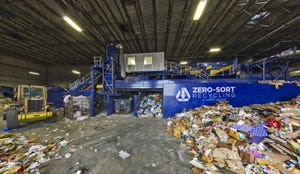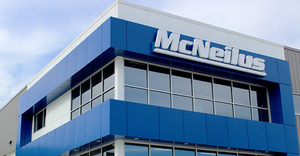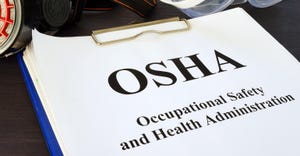A Smoother Road
Though it's still early in the development process, meeting the 2010 engine emission regulations may not be as painful as many fear.
There's virtually no doubt that getting trucks to comply with the 2010 emission regulations is going to add more dollars to the sticker price — probably a lot more, something most refuse fleets would rather not hear.
Still, truck manufacturers say that, despite some uncertainties, meeting the 2010 requirements shouldn't be nearly as challenging as meeting the 2007 regulations.
“Not only won't we have the heat load issue, we won't have to deal with all the engine and cab modifications we went through for 2007,” says Tom Vatter, vice president of sales and marketing for Hagerstown, Ind.-based Autocar LLC. “The physical impacts from the 2007 rules on the truck itself were really huge. We're still dealing with them. But with 2010, that won't be the case.”
By 2010, new diesel engines will be required to emit no more than 0.2 grams per brake horsepower hour (g/bhp-hr) of nitrogen oxide (NOx) and 0.14 g/bhp-hr of non-methane hydrocarbons (NMHC).
Selective Catalytic Reduction
Several truck manufacturers — including Volvo, Mack Trucks, Detroit Diesel and Paccar — have decided to use selective catalytic reduction (SCR) systems to comply with the 2010 requirements.
“One of the biggest issues for refuse trucks in meeting the recent 2007 emission standards revolved around the amount of cooling they needed for their engines,” says Tony Grenzler, vice president of advanced engineering for Hagerstown, Md.-based Volvo Powertrain North America. “With the SCR [selective catalytic reduction] system, we're looking to use for our engines to meet the 2010 rules, we can reduce the heat loads on the engine. That helps reduce its cooling needs and improves fuel economy as well.”
Allentown, Pa.-based Mack, which is owned by the Volvo Group, has been running SCR systems on prototype trucks since 2000, logging more than two million miles on 10 customer vehicles, says Paul Vikner, president and CEO of Mack. Additionally, the Volvo Group has logged more than 23 million miles of SCR road testing in Europe, and has produced more than 40,000 SCR-equipped vehicles since the Euro 4 emissions standards took effect in October 2006, Vikner says.
The appeal of an SCR system is relative simplicity. Nothing else gets added to the vehicle other than a small tank of urea — a liquid compound composed of 34 percent ammonia and 66 percent water — along with extra wiring and sensors to manage the injection flow of urea into the truck's exhaust stream to convert harmful NOx emissions into water vapor.
“We're going to be using the same engine designs and diesel particulate filters [DPFs] in use now to meet the '07 levels, so there won't be any changes there,” says Ed Saxman, product manager-drivetrain for Greensboro, N.C.-based Volvo Trucks North America. “What is going to change is that we're going to add an SCR system to reduce NOx emissions. While it's still premature to talk about costs — more sensors and hardware will be required — it really isn't complicated or even new technology. We're already using it on many of our engines in Europe.”
Volvo's entire SCR system, including wiring, hoses and urea container, won't be much larger than the DPFs currently in use, Saxman adds.
“We don't need a huge amount of urea either,” adds Tim Tindall, director of component sales for Redford, Mich.-based Detroit Diesel Corp. (DDC). “Roughly, for every 100 gallons of diesel fuel, you'll only need one gallon of urea. We're planning for a four or five gallon urea tank, which would add about 50 or 60 lbs. to the truck.”
According to Saxman, distribution of urea would be simple, too, with 2.6 liter bottles of the substance being sold in truckstops, dealerships, parts stores and other locations so drivers can keep their urea tanks filled up. An SCR system also may help engine makers improve fuel economy, he adds.
“The great thing about SCR is that you can tune it to handle higher emissions of NOx easily, meaning you can relax the NOx controls on the engine, letting NOx get cleaned up in the exhaust stream,” he says. “Right now, we're looking at up to a 5 percent increase in fuel economy by using SCR,” a figure that could rise.
Other Technologies
While both Volvo and DDC are planning to use SCR on their 2010 engines and are already deep into testing prototype SCR systems for the U.S. market, it's not the only technology under consideration by manufacturers.
Peoria, Ill.-based Caterpillar, according to District Manager Eric Arnold, is still debating whether to use SCR or another technology — NOx adsorbers — for its truck engines. Warrenville, Ill.-based International Truck & Engine Corp. also is on the fence regarding its technological path to 2010 and isn't ready to talk yet. “It's still too early,” says Melissa Gauger, the company's waste segment manager. “We're not ready to discuss 2010 yet because we're still looking at different technologies.”
NOx adsorbers are the major alternative to SCR systems, and they work by adsorbing NOx from the exhaust and converting it to non-polluting nitrogen during a regeneration cycle, according to Tempe, Ariz.-based Catalytica Energy Systems, which manufacturers both NOx adsorbers and SCR components.
In a white paper, Catalytica explains that adsorber technology offers considerable NOx reduction capabilities, but performance issues related to durability, operating range and fuel economy have so far limited their real-world viability. In most cases, diesel fuel injected at the engine or in the exhaust system upstream of the NOx adsorber is used for the regeneration cycle, which can give good performance at high exhaust temperatures, but poor performance at lower levels.
The problem, of course, is that low exhaust temperatures represent a large portion of vehicle operating time, particularly for medium- and light-duty diesel engine applications used in urban areas, Catalytica says.
However, the company says that new NOx adsorber designs are addressing low-temperature needs, with recent testing indicating they control 90 percent of NOx emissions over a broad range of operating conditions — with a total fuel economy impact of less than 3 percent. Catalytica also believes the combination of its diesel fuel processor with a NOx adsorber should allow for the creation of a practical NOx reduction solution to comply with 2010 emissions requirements and maximize fuel efficiency.
Operational Impact
Regardless of the technology — SCR or NOx adsorbers — truck prices are still going to rise in 2010, though perhaps not as steeply as in 2007. The operational impact also is going to be noticeable.
According to Bernard Heil, vice president of truck product engineering powertrain for Germany's DaimlerChrysler AG (which owns the Freightliner, Sterling and Western Star truck brands in the United States), SCR-based emissions reduction systems should add approximately $4,000 to the cost of a new truck. However, improvements to fuel economy by using SCR — up to 7 percent in European trucks, he says — could help offset that higher sticker price cost to a degree over the life cycle of the vehicle.
An SCR system's urea tank also needs to be refilled from time to time, adding an ongoing — if minimal — operational cost to keep the truck in compliance with the law. “You're looking at a 2 percent to 3 percent fuel-to-urea ratio,” says Volvo's Grenzler. “That works out roughly to two to three gallons of urea per 100 gallons of fuel. And the storage tank doesn't have to be pressurized, so it'll be made of tough but light plastic. That saves on weight.”
Urea does freeze below 11 degrees Fahrenheit, however, so ways to keep the tank warm are being looked at. Yet Grenzler doesn't think that will pose much of a problem for refuse fleets, as their mode of operation generates more than enough continual engine heat to keep the urea in liquid form. And even if it does freeze, the urea is still good, so it can be thawed out and put right back into use, he notes.
“Overall, the SCR system — urea tank, injectors, sensors and wiring harness — really won't require that much maintenance, nowhere near what's needed for DPFs,” Grenzler says.
One concern the U.S. Environmental Protection Agency (EPA) long held about SCR centered on the need to refill the urea tank, as the agency worried that fleets might keep their vehicles operating while using overly diluted urea formulas or even none at all. Part of the challenge then is to make SCR systems sensitive enough to recognize when the urea formulations are not adequate, so they can reduce and eventually shut down the engine until the proper amount of liquid is used.
As for NOx adsorbers, there's a lot more gray area in terms of pricing and performance impact, largely because the technology isn't in widespread use like SCR. In a 2005 study, EPA estimated a NOx adsorber system would add anywhere from $1,500 to $3,000 to the capital cost of a vehicle, based on its engine horsepower (the lower the horsepower, the less expensive the NOx adsorber would be). However, the EPA also found that NOx adsorbers would cause fuel economy to decline anywhere from 1 percent to 3 percent, depending on the truck's mode of operation.
The operational impact and maintenance needs of NOx adsorbers are the biggest unknowns, however, as the technology is still largely in the testing phase. What is the service interval for NOx adsorbers — do they need to be “swapped out” after a certain number of miles or hours of operation, like DPFs? That's still undetermined. How large does the adsorber have to be and how near to/far from the engine must it be located? That, too, is as yet undetermined.
Fleet operators are set for another round of adjustments in 2010. Fortunately, the experience is shaping up to be less traumatic than the 2007 experience.
Sean Kilcarr is senior editor for Fleet Owner, a sister publication of Waste Age.
THE CLEANER AIR TIMELINE
Truck emission regulations have come in stages. In October 2002, the Washington-based U.S. Environmental Protection Agency (EPA) required new heavy-duty diesel engines to emit no more than 0.1 grams per brake horsepower hour (g/bhp-hr) of particulate matter (PM), 2 g/bhp-hr oxides of nitrogen (NOx), and between 0.4 and 0.5 g/bhp-hr of non-methane hydrocarbons (NMHC). In 2004, the rules were expanded to include medium- and light-duty diesel truck engines.
This year, emission level requirements for new diesel engines became even stricter. PM emission levels decreased to 0.01 g/bhp-hr, NOx to 0.2 g/bhp-hr and NMHC to 0.14 g/bhp-hr. The PM requirement was implemented fully, while the NOx and NMHC requirement will be phased-in between now and 2010. As a result, new diesel engines in 2010 will produce less than 10 percent of the emissions of 2001 models.
To meet the 2007 rules, the sulfur content of diesel has been reduced. In 2006, diesel sulfur dropped to 15 parts per million (ppm) from 500 ppm. The EPA requires terminals to offer the ultra low sulfur diesel (ULSD). The agency also is requiring that, by 2010, 100 percent of the diesel fuel sold in the country meet the 15 ppm standard.
About the Author
You May Also Like


